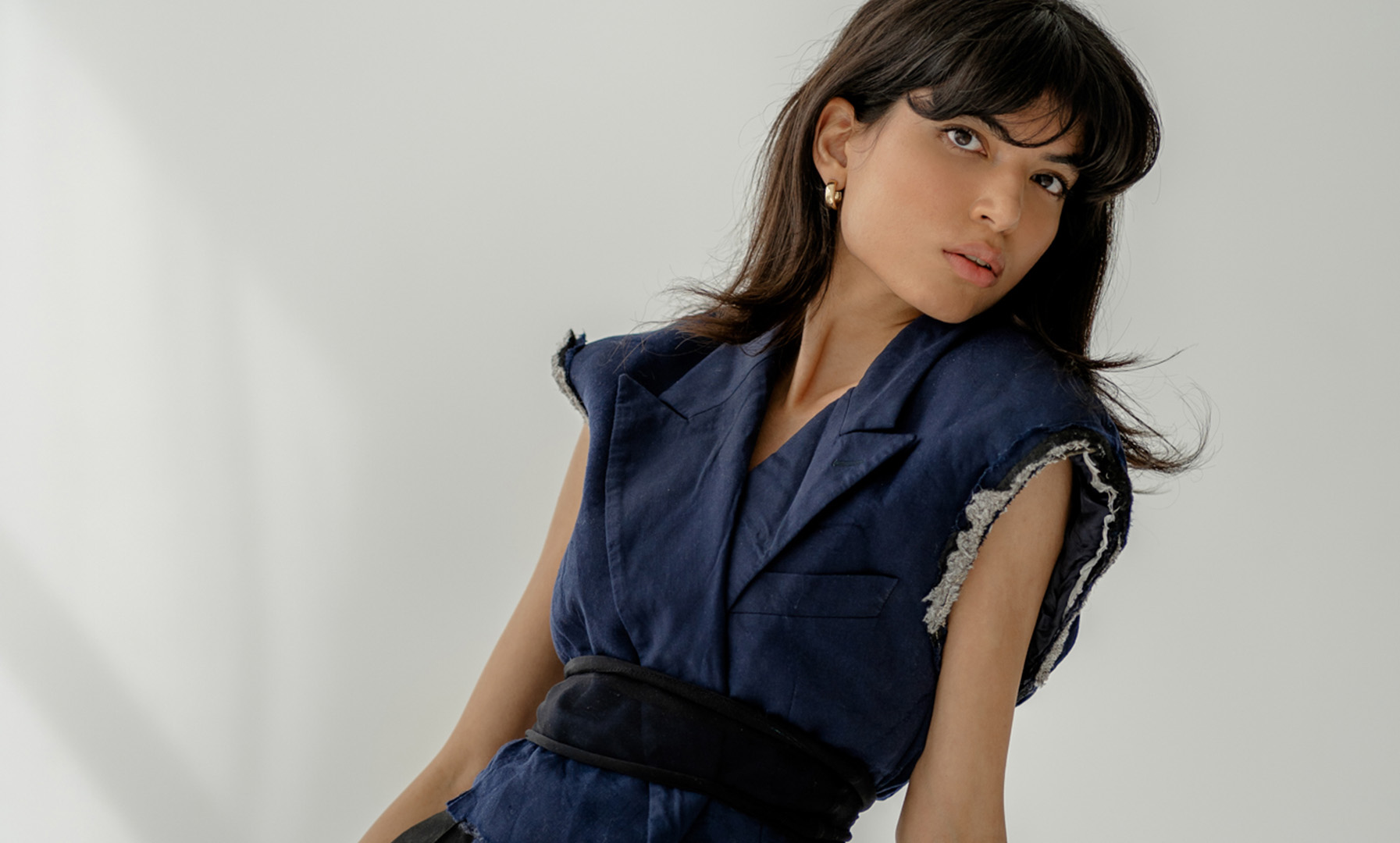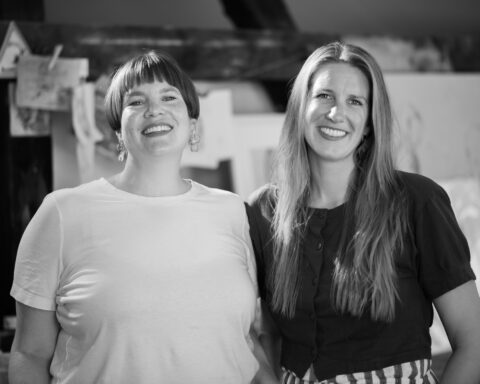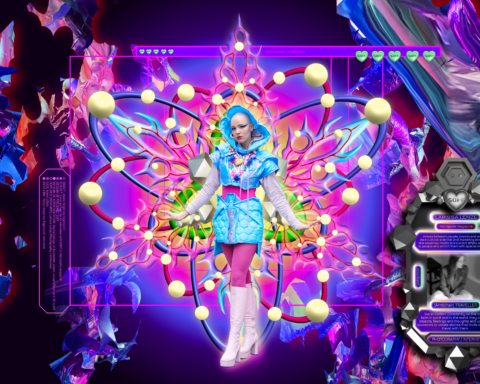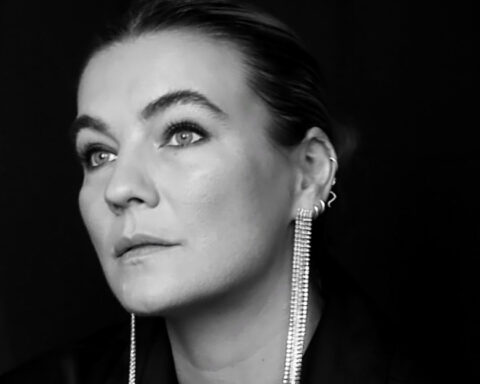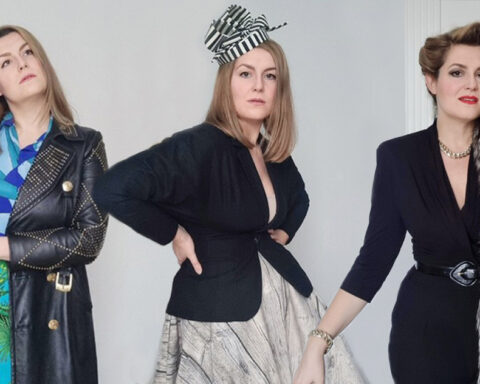Mode und Informatik – auf den ersten Blick haben diese beiden Branchen nichts miteinander zu tun. Doch in Zwenkul Kakkar finden sie zusammen. Die junge Frau hat es schon jetzt von Düsseldorf in die Modemetropolen Europas geschafft und will nun weltweit als Model durchstarten. Ihrer Leidenschaft für das Programmieren will sie dabei treu bleiben. Ich habe Zwenkul zum Interview getroffen und mit ihr über Fashion, Coding, Kreativität und ihr Leben zwischen den Welten gesprochen.
Liebe Zwenkul, vielleicht beginnen wir ganz am Anfang. Wie bist Du zum Modeln gekommen?
Während eines Auslandssemesters wurde ich von einem Mann angesprochen. Er kam direkt auf mich zu und fragte, ob ich Interesse daran hätte, als Model zu arbeiten. Damals nahm ich das nicht wirklich ernst, aber zu dieser Zeit – es muss 2018 oder 2019 gewesen sein – fragte ich mich zum ersten Mal, wie es wohl wäre, Model zu sein.
Als sich die Situation wiederholte und der Gedanke einige Zeit in mir reifen konnte, nahm ich das Ganze ernst. Ich fing an Bilder zu machen und lernte junge Designer*innen kennen, die Interesse zeigten, mit mir zu arbeiten. Ich hatte damals keine Idee, wohin das führen würde. Nachdem einige der Aufnahmen online waren, fand mich Veronique Kern von SMC Model Management auf Instagram und fragte, ob ich Interesse hätte, professionell zu modeln.
Bis zu diesem Moment war Modeln eher ein Traum für mich. Ich habe es gerne in der Freizeit gemacht, hielt es aber nicht für realistisch, es jemals als Beruf ausüben oder Geld damit verdienen zu können. Als wir das erste Mal telefonierten erklärte mir Veronique, wie die Arbeit mit der Agentur funktioniert, was ihr Ziel sei und wie wir meine Wünsche und Ideen gemeinsam angehen könnten. Kurz darauf trafen wir uns in Berlin mit ihrem Sohn Alex und fingen an zu arbeiten.
Natürlich war es ganz anders als alles, was ich bisher kannte. Die beiden erklärten mir, wie sie mich Schritt für Schritt aufbauen würden, um mir eine langfristige Karriere zu garantieren. Sie haben mich gecoached – ich wusste gar nicht, dass das Teil des Berufs sein würde – aber ich verstand schnell, wie wichtig dieser Teil der Ausbildung ist, um auf die Herausforderungen des Modellebens vorbereitet zu sein. Ich fühlte mich direkt sicher bei SMC und entschied, die Chance zu nutzen und das Modeln hauptberuflich anzugehen. Das war im August 2022.

Was reizt Dich besonders am Modeln?
Ich bin in einer indisch afghanischen Familie aufgewachsen und die Freude an kreativem Ausdruck gehört zu meinem Alltag. Ich hatte immer Lust daran, meine kreative Seite auszuleben, habe viele Filme gesehen, mich für Tanz interessiert und bin später auf Modenschauen und Magazine gestoßen. Mode als Darstellungsform hat mich immer fasziniert und irgendwann habe ich gesehen, dass Mädchen in meinem Alter in dieser Branche Karriere machen. Das hat natürlich meine Fantasie angeregt.
Wie schön, dass dieser Traum mit 23 dann tatsächlich in Erfüllung gehen durfte! Wie kann ich mir denn aktuell Deinen Alltag als Model vorstellen?
Eigentlich sieht jeder Tag anders aus. Ich habe gelernt, dass man als Model flexibel sein muss. Es kann immer sein, dass die Agentur anruft, weil sich eine neue Möglichkeit aufgetan hat. Besonders intensiv ist es natürlich, wenn man sich auf die Fashion Weeks vorbereitet. Es gibt sehr viele Castings, Anfragen kommen herein und man muss schnell reagieren, das heißt, immer verfügbar sein. Darüber hinaus verbringe ich viel Zeit mit Fitness und Ernährung und bereite mich auf Jobs vor. Im ersten Jahr war ich vorwiegend in Europa unterwegs, also in Städten wie Paris, Mailand und Berlin. Aber gerade im Luxusbereich können Jobs überall auf der Welt stattfinden.
Bist Du nach diesem intensiven ersten Jahr als Model schon dazu gekommen, einen Realitätscheck zu machen? Was waren Erwartungen, die Du hattest? Welche davon habe sich tatsächlich erfüllt? Was war vielleicht ganz anders, als Du es Dir vorgestellt hast?
Ich habe meine Ziele für das erste Jahr in einer Excel-Tabelle notiert und mich natürlich ordentlich verschätzt. Ein Jahr ist nicht viel, deshalb habe ich sie mittlerweile auf fünf Jahre erweitert. Das ist ein realistischer Horizont.
Es ist einiges passiert, mit dem ich nicht gerechnet habe. Beispielsweise die mentale Arbeit, mit der ich auf das Modeln und mögliche psychischen Belastungen des Berufs vorbereitet wurde. Dazu der kreative Prozess. Fotoshootings nehmen sehr viel Raum ein. Mein ganzes Buch wurde von der Agentur geplant und ich war sehr dankbar für das Wissen, dass mir Alex und Veronique über die Branche vermittelt haben. Wenn ich heute in Magazine schaue, erkenne ich ganz andere Muster und habe durch unsere Gespräche ein ganz neues Gespür für Mode und Trends entwickelt. Diesen Prozess und das Wissen, das mit dem Job verbunden ist, habe ich absolut unterschätzt.
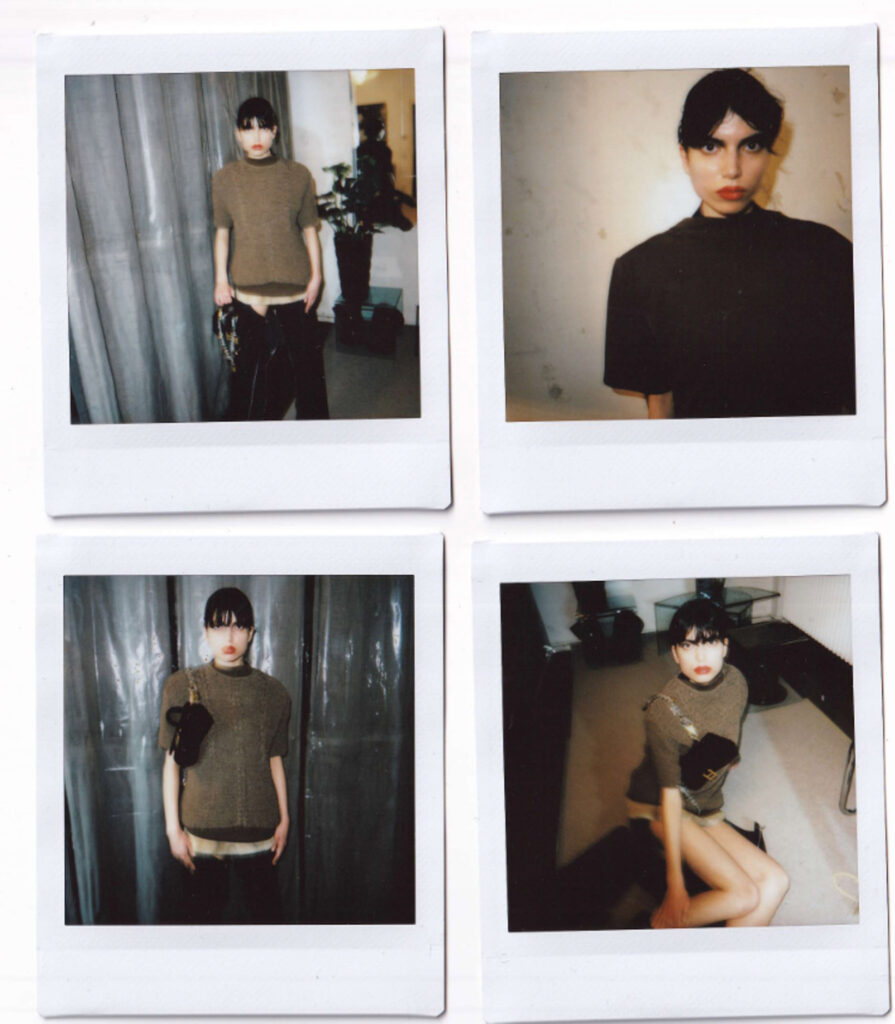
Gibt es einen Moment, den Du im letzten Jahr erlebt hast, der Dir besonders in Erinnerung geblieben ist oder der Deine Arbeitsweise nachhaltig beeinflusst hat?
Da gab es sicher einige. Besonders prägend fand ich die Arbeit mit anderen Models. Wenn ich sehe, wie andere arbeiten – wie diszipliniert und professionell sie sind – inspiriert mich das sehr. Ich habe das Gefühl, bei jeder Begegnung etwas Neues von meinen Kolleginnen und Kollegen zu lernen.
Der entscheidende Moment im letzten Jahr war wohl das Kennenlernen mit SMC. Ich habe im Voraus viel über die Arbeit mit Agenturen gehört und die Geschichten waren nicht immer positiv. Teilweise haben sie Hunderte von Models unter Vertrag. Ich habe mich gefragt, wie es möglich ist, in solchen Umgebungen überhaupt Aufmerksamkeit zu bekommen. Als ich Veronique und Alex kennenlernte, habe ich gemerkt, dass es auch anders sein kann. Wir sind fast täglich in Kontakt, die beiden wissen immer, wo ich gerade stehe, was mein nächster Schritt sein sollte und haben für jedes Model eine konkrete Karriereplanung. Mit diesem Hintergrund ist es mir leicht gefallen zu vertrauen und dem Beruf eine Chance zu geben.
Was würdest Du tun, wenn Du kein Model geworden wärst?
Ich habe Informatik studiert. Wahrscheinlich würde ich in Vollzeit als Programmiererin arbeiten.
Das klingt nach einer sehr ungewöhnlichen Kombination. Kennst Du noch andere Models, die programmieren?
Ich habe von ein oder zwei Models gehört, sie aber bisher nicht persönlich kennengelernt. Das berühmteste Beispiel ist wahrscheinlich Karlie Kloss. Für mich ist sie eine echte Inspiration. Es ist schön zu wissen, dass es auch andere gibt, die mit dieser Kombination an Talenten erfolgreich waren und es bis heute sind.
Leider stehen viel zu wenig Frauen in der Öffentlichkeit, die programmieren. Die Welt der Informatik ist vorwiegend männlich geprägt, das schreckt viele Frauen von einem Studium ab. Aber ich habe das Gefühl, dass wir immer mehr werden. Ich glaube aktuell wächst das Verständnis dafür, dass Programmierung eine sehr kreative Arbeit ist. Auch dadurch wird das Fach attraktiver für Frauen. Ich hoffe, dazu einen Teil beitragen zu können.
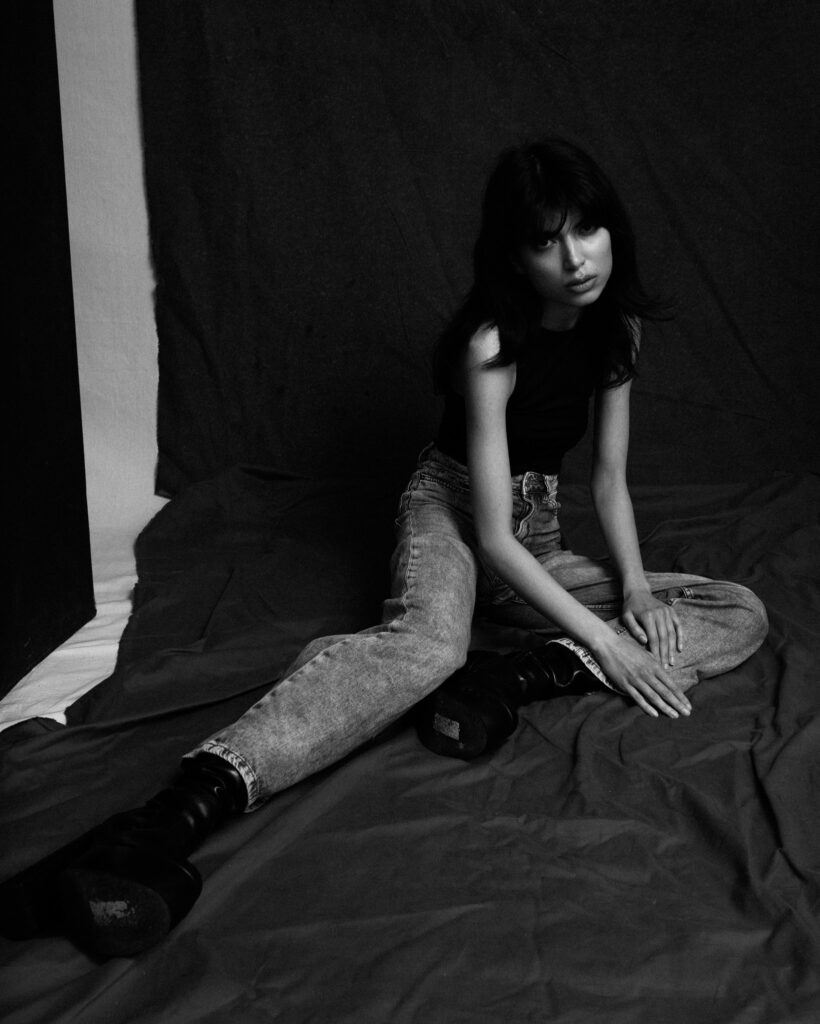
Wie bist Du zum Programmieren gekommen?
Als ich in der achten Klasse war, wurde uns von einem älteren Herrn aus der Schulbibliothek beigebracht, wie man mit Excel arbeitet. Damals hieß das Fach noch ‚elektronische Datenverarbeitung‘. Ich fand das ziemlich cool und bin nach der Stunde auf ihn zugegangen. Er erklärte mir, was man studieren muss, um das professionell zu machen und ich fing selbstständig an, Homepages zu bauen. Als ich irgendwann an einem Coding Bootcamp teilnahm, merkte ich, dass Programmieren gar nicht so schwierig ist, wenn man sich nur intensiv genug damit beschäftigt. Kurz daran habe ich angefangen, Informatik zu studieren.
Hast Du innerhalb des Studiums Eigenschaften entwickelt, die Du in Deinem heutigen Job gut brauchen kannst?
Als Frau im Informatikstudium fällt man grundsätzlich auf. Als Frau mit Interesse an Mode, ist es noch schlimmer. Zu Beginn wurde ich häufig auf mein Geschlecht, mein Aussehen und meine Interessen reduziert und damit auch meine Fähigkeiten in Frage gestellt. Ich musste stark sein, über Jahre mit Vorurteilen kämpfen und mir immer wieder selbst bestätigen, dass ich richtig bin an diesem Ort. Dadurch habe ich definitiv eine dicke Haut entwickelt.
Als Model helfen mir diese Erfahrungen heute sehr. Man muss selbstbewusst sein, für sich einstehen und an sich selbst glauben. Es gilt, immer wieder den Status Quo zu hinterfragen, sich fortwährend zu verbessern und Disziplin zu beweisen. Ich glaube, das habe ich in meinem Studium gelernt.
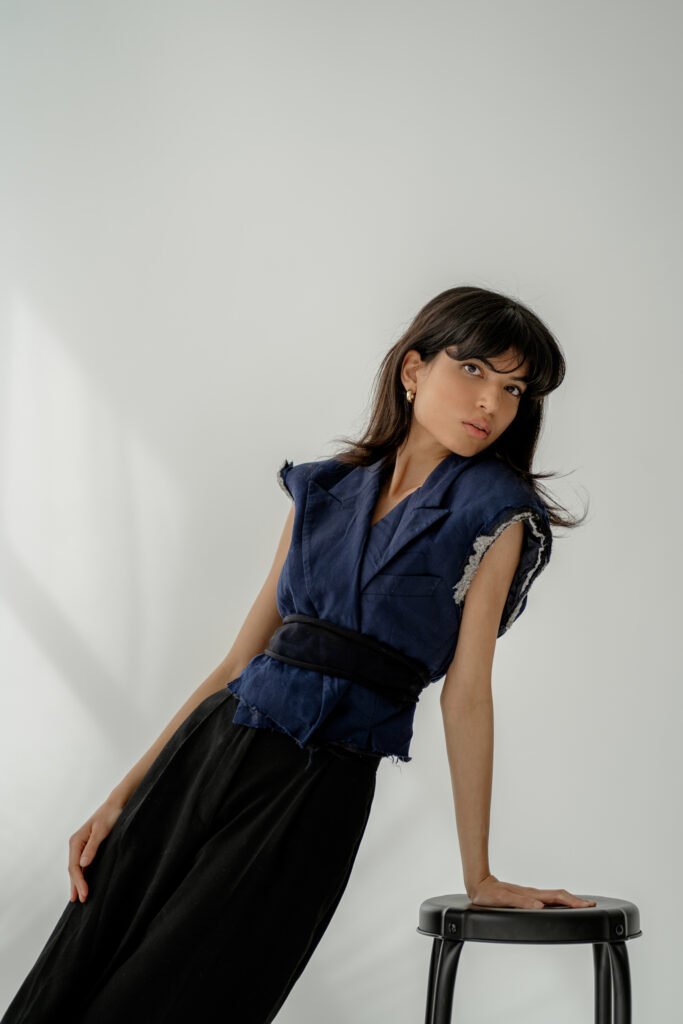
Gibt es noch mehr, das Dich von anderen Models unterscheidet?
Wahrscheinlich das Umfeld, in dem ich aufgewachsen bin. Die afghanisch-indische Kultur ist bis heute ein großer Teil meiner Identität. Ich bin in Deutschland geboren und habe einige Jahre meiner Kindheit in Indien verbracht. Diese Zeit war sehr prägend für mich. In Indien ist alles anders als in Deutschland. Es ist sehr laut, die Menschen sind sehr extrovertiert und echte Selbstdarsteller*innen. Die indische Kultur ist stark durch Musik geprägt, sehr bunt und voller Kreativität. Außerdem haben die Inder*innen kein Problem damit, für sich selbst einzustehen und ihr eigenes Ding durchzuziehen. Das hat mich sehr inspiriert und dazu motiviert, meinen eigenen Weg zu gehen.
Mit den aktuellen technischen Möglichkeiten und ihrem öffentlichen Zugang wird es immer einfacher, Models durch künstliche Intelligenz zu generieren. Aktuell wird diese Möglichkeit – vor allem aus urheberrechtlichen Gründen – noch nicht kommerziell genutzt. Wie stehst Du zu diesen Entwicklungen und wo glaubst Du liegt der Vorteil, mit wirklichen Models zu arbeiten?
Als Informatikerin finde ich die aktuellen technischen Entwicklung super spannend. Als Model sollte ich mich wahrscheinlich bedroht fühlen. Doch so denke ich nicht. Designer*innen konzipieren Mode für Menschen. Viele Designs sind so emotional, dass ich mir nicht vorstellen kann, wie sie ohne ein wirkliches Model, ein echtes Fotoshooting und alles, was dazugehört ihre volle Wirkung entfalten sollten. Ich erlebe immer wieder, wie komplex die Zusammenarbeit in der Branche ist. Der Weg von einer Idee, über die Kreation bis hin zum Bild in einem Magazin oder Katalog ist lang und die vielen Menschen, die hier involviert sind, geben dem Ergebnis erst seine wahre Strahlkraft. Ich glaube nicht, dass sich diese Arbeit so schnell und in vergleichbarer Qualität mit künstlicher Intelligenz abbilden lässt.
Mit welchen Herausforderungen siehst Du Dich durch Deinen technischen Hintergrund in der Modebranche konfrontiert und wie kannst du ihn andersherum positiv für Deine Arbeit als Model nutzen?
Die einzige Herausforderung, die ich sehe, sind die klaren Prioritäten, die ich bei meiner Arbeit setzen muss. Sowohl das Modeln als auch die Programmierung sind sehr zeitintensive Berufe. Deshalb ist es wichtig, dass ich mich voll auf das Modeln konzentriere und nur sehr wenige und kleine Jobs als selbstständige Programmiererin annehme, wo ich in der Front-End-Entwicklung Benutzeroberflächen von Webanwendungen gestalte und entwickle.
Positiv empfinde ich, dass ich als Programmiererin viel Geduld mitbringe und früh gelernt habe, kreativ zu Denken. Ich bin gut darin, ungewöhnliche Lösungen zu finden und weiß um die Dauer, die ein kreativer Prozess haben kann. Ob beim Modeln oder Programmieren – wenn etwas nicht beim ersten Mal funktioniert, darf man sich nicht direkt demotivieren lassen. Es ist ein Prozess. Ich glaube, ich habe ein sehr großes Bewusstsein für die Arbeit, die hinter einem Ergebnis steckt. Dadurch habe ich eine ganz andere Wertschätzung für die Menschen, die beispielsweise an einem Shooting beteiligt sind oder für die Kreationen der Designer*innen. Außerdem spielt in der Informatik Teamwork eine große Rolle, denn man kann nichts Großes alleine erschaffen. Dasselbe sehe ich beim Modeln. Man muss eng mit der Agentur, mit Kund*innen genauso wie mit anderen Models zusammenarbeiten, um am Ende ein gutes Ergebnis zu erzielen.
Du hast viel von Kreativität gesprochen. In welchen Elementen des Modelns steckt denn das Kreative für Dich?
Kreativität spiegelt sich für mich eigentlich in allen Elementen des Jobs wider. Beim Shooting kann das beispielsweise die Interaktion mit den Fotografierenden sein, genauso wie das Styling, die Designs selbst oder die Wahl der Shooting-Umgebung.
Auf dem Laufsteg denke ich direkt an das Setting, das speziell ausgewählte Publikum, die Inszenierung der Modenschau, die Interaktion unter den Teilnehmenden oder auch die Wahl des Laufstils. Das alles ist ein Zusammenspiel zwischen Menschen, die versuchen, eine Vision Wirklichkeit werden zu lassen.
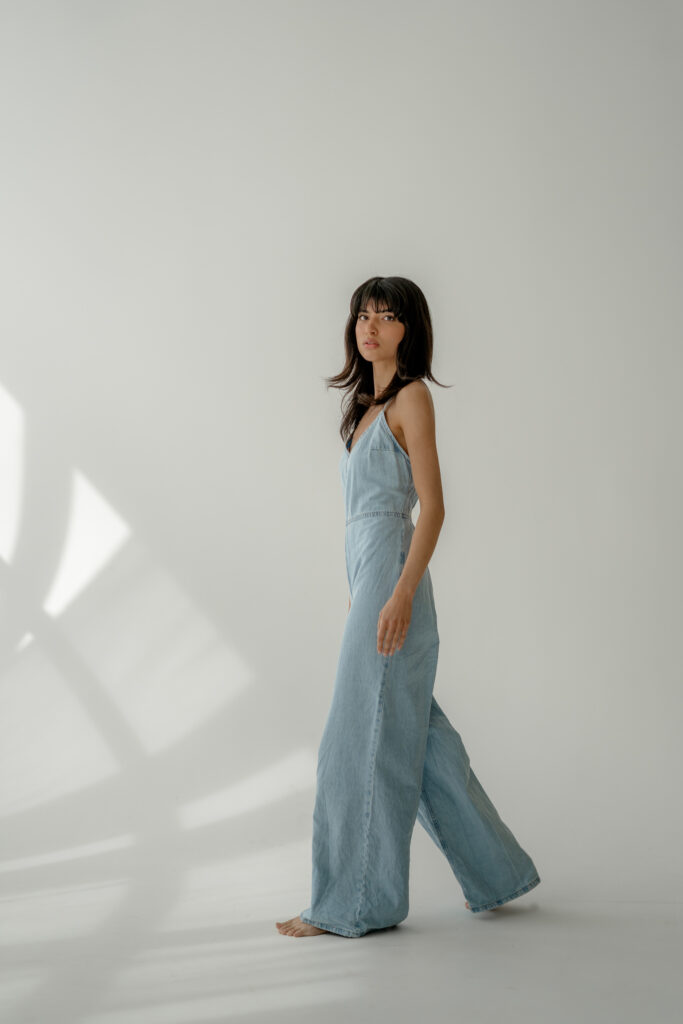
Für welche Designer oder Magazine würdest Du gerne arbeiten?
Erstmal freue ich mich auf alles, was mir bevorsteht, weil ich einfach so viel Lust habe, zu lernen und mit verschiedenen Menschen zusammenzukommen. Mich interessiert ganz besonders der Bereich High Fashion, weil ich seit meiner Kindheit fasziniert in den großen Modemagazine geblättert habe. Etwas ganz Besonderes wäre für mich, eine Strecke in meinem Heimatland shooten zu dürfen, in Indien.
Welche Herausforderungen siehst Du gerade für die Modebranche?
Eine der zentralen Herausforderungen der Branche ist sicherlich noch immer das Thema Diversität. Natürlich ist hier schon viel passiert. Mittlerweile sind Menschen aus vielen unterschiedlichen Ländern und mit den unterschiedlichsten Körperformen auf den Laufstegen vertreten. Doch es gibt noch immer einen Prototyp, der Bilder und Runways dominiert.
Und welche Chancen siehst Du für die Branche?
Genau hier liegen für mich auch die Chancen. Ich finde es so inspirierend, Frauen in Magazinen und Modenschauen zu sehen, die mir ähnlich sind. Dieses Gefühl wünsche ich mir für so viele Menschen wie möglich.
Welche Relevanz haben Instagram und TikTok, um als Model erfolgreich zu sein?
Ohne meinen Instagram Kanal wäre meine Agentur nie auf mich aufmerksam geworden. Es ist ein sehr gutes Tool, um entdeckt zu werden und als Model Sichtbarkeit zu bekommen. Es ist wie ein selbst kuratiertes Portfolio, eine Visitenkarte und nach meiner Erfahrung ganz essentiell, um erfolgreich zu sein. Wenn die Agentur ein Model für einen Job vorschlägt, schauen Designer*innen sich häufig als erstes ihre Bilder auf Instagram an.
Glaubst Du, dass Selbstdarstellung und Persönlichkeit für Models immer wichtiger werden?
Absolut. Ich glaube als Model muss man sehr wandelbar sein, darf in den passenden Momenten aber auch seine Persönlichkeit und seine ganz individuellen Eigenarten hervorscheinen lassen.
Warum ist das Modeln Dein Traumberuf?
Ich liebe es, neue Menschen und andere Länder kennenzulernen. Als Model tauche ich immer wieder in andere Welten ein und spiele andere Rollen. Das finde ich unglaublich schön. Ein Tag am Set fühlt sich für mich nicht an wie Arbeit. Das Modeln macht mir sehr viel Spaß und ich hoffe, dass ich diesen Beruf lange ausüben darf.
Vielen Dank, liebe Zwenkul.
In between worlds
Fashion and IT – at first glance, these two industries seem to have nothing to do with each other. But they come together in Zwenkul Kakkar. The young woman has already made it from Düsseldorf to the fashion capitals of Europe and now wants to make a global breakthrough as a model. Still, she wants to remain true to her passion for programming. I met Zwenkul for an interview and talked to her about fashion, coding, creativity and her life between two worlds.
Dear Zwenkul, perhaps we should start at the very beginning. How did you get into modelling?
I was approached by a man during a semester abroad. He approached me directly and asked if I would be interested in working as a model. I didn’t really take it seriously at the time, but at that time – it must have been 2018 or 2019 – I thought about what it would be like to work as a model for the first time.
When the same situation repeated itself and the idea had some time to mature, I took it seriously. I started taking my first pictures and quickly came across young designers who were interested in working with me. At the time, I had no idea where it could all lead. After some of the shots were online, Veronique Kern from SMC Model Management found me on Instagram and approached me directly. She asked if I would be interested in modelling professionally.
Until that moment, modelling was more of a dream for me. I enjoyed doing it in my spare time, but never thought it was realistic that I would ever be able to pursue it as a career or earn money from it. The first time we spoke on the phone, she explained to me how modelling with her agency worked, what her goal was and how we could tackle my wishes and ideas together. Shortly afterwards, we met in Berlin with her son Alex and started working.
Of course, it was very different to anything I had ever experienced before. The two of them explained to me how they would build me up step by step to guarantee me a long-term career so that I wouldn’t just be able to model at a young age and then never again. They coached me – I didn’t even realise that this would be part of the job – but I quickly understood how important this training was to be prepared for the challenges of the profession. I immediately felt safe with the two of them and decided to take the opportunity and pursue modelling full-time. That was in August 2022.

What appeals to you most about modelling?
I grew up in an Indian Afghan family and the joy of creative expression is part of my everyday life. I always wanted to express my creative side, watched a lot of films, was interested in dance and later came across fashion shows and magazines. I quickly became fascinated by fashion as a form of expression and at some point I saw that girls my age were making a career in this industry. Of course, that fuelled my imagination.
How wonderful that this dream actually came true when I was 23! How can I imagine your everyday life as a model at the moment?
Actually, every day is different. I quickly learnt that you have to be flexible as a model. It’s always possible that the agency will call because a new opportunity has arisen. Of course, it’s particularly intense when you’re preparing for Fashion Weeks. There are a lot of castings, requests come in and you have to react quickly, which means always being available. I also spend a lot of time on fitness and nutrition and preparing for jobs. In my first year, I was mainly travelling in Europe, in cities like Paris, Milan and Berlin. But especially in the luxury sector, jobs can take place anywhere in the world.
After this intensive first year as a model, have you had time to do a reality check? What were your expectations? Which of them actually materialised? What was perhaps completely different from what you had imagined?
I wrote down all my goals for the first year in an Excel spreadsheet. Of course, I really misjudged them – one year is not much – but I have now extended them to five. That’s a realistic horizon.
A lot has happened that I didn’t expect. For example, the mental work that prepared me for modelling and the possible psychological stresses of the job. Plus the creative process. Photo shoots take up a lot of space. My entire book was planned by the agency and I was very grateful for the knowledge they gave me about the industry. When I look at magazines today, I recognise completely different patterns and have developed a whole new sense of fashion and trends through our conversations. I completely underestimated this process and the knowledge that comes with the job.

Is there a moment that you have experienced in the last year that you particularly remember or that has had a lasting impact on the way you work?
There have certainly been a few. I’ve always found working with other models particularly formative. When I see how others work – how disciplined and professional they are – it really inspires me. I feel like I learn something new from my colleagues every time I meet them.
The decisive moment last year was probably getting to know SMC. I heard a lot about working with agencies in advance and the stories weren’t always positive. Sometimes they have hundreds of models under contract. I wondered how it was possible to get any attention at all in such environments. When I met Veronique and Alex, I realised that it could be different. We are in contact almost daily, they always know where I am at, what my next step should be and have a concrete career plan for each model. With this background, it was easy for me to trust them and give the job a chance.
What would you be doing if you hadn’t become a model?
I studied computer science. I would probably be working full-time as a programmer.
That sounds like a very unusual combination. Do you know any other models who programme?
I’ve heard of one or two models, but I haven’t met them in person yet. The most famous example is probably Karlie Kloss. She’s a real inspiration for me. It’s nice to know that there are others who have been successful with this combination of talents and still are today.
Unfortunately, very few women who code are visible in public. The world of #computerscience is mostly male-dominated, which puts many women off studying. But I still have the feeling that there are more and more of us. I think there is a growing understanding that #programming is not only dry and rational but also highly #creative work. This makes the subject more attractive – especially for women. I hope I can play a part in this development.

How did you get into programming?
When I was in eighth grade, we were taught how to work with Excel by an older gentleman from the school library. Back then, the subject was still called ‚electronic data processing‘. I thought it was pretty cool and approached him after the lesson. He explained to me what I needed to study in order to do it professionally and I started building homepages on my own. When I took part in a coding bootcamp at some point, I realised that programming isn’t that difficult if you work hard enough. Shortly afterwards, I started studying computer science.
Did you develop qualities during your studies that you can use in your current job?
As a woman studying computer science, you always stand out. As a woman with an interest in fashion, it’s even worse. At the beginning, I was often reduced to my gender, my appearance and my interests, which meant that my abilities were also questioned. I had to be strong, fight against prejudice for years and constantly reassure myself that I was in the right place. I definitely developed a thick skin as a result.
As a model, these experiences help me a lot today. You have to be self-confident, stand up for yourself and believe in yourself. You have to keep questioning the status quo, keep improving and show discipline. I think I learnt that during my studies.

Is there anything else that sets you apart from other models?
Probably the environment in which I grew up. The Afghan-Indian culture is still a big part of my identity today. I was born in Germany and spent several years of my childhood in India. This time was very formative for me. Everything is different in India than in Germany. It’s very loud, people are very extroverted and real self-promoters. Indian culture is strongly influenced by music, very colourful and full of creativity. Indians also have no problem standing up for themselves and doing their own thing. That inspired me a lot and motivated me to go my own way.
With the current technical possibilities and their public access, it is becoming easier and easier to generate models through artificial intelligence. At the moment, this possibility is not yet being used commercially – mainly for copyright reasons. What do you think about these developments and what do you think is the advantage of working with real models?
As a computer scientist, I find the current technical developments super exciting. As a model, I should probably feel threatened. But that’s not how I feel. Designers create fashion for people. Many designs are so emotional that I can’t imagine how they could have their full effect without a real model, a real photo shoot and everything that goes with it. I experience time and again how complex collaboration in the industry is. The path from an idea, through creation, to the image in a magazine or catalogue is a long one and the many people involved here are what give the result its true radiance. I don’t believe that this work can be reproduced so quickly and in comparable quality with artificial intelligence.
What challenges do you face due to your technical background in the fashion industry and how can you use it positively for your work as a model?
The only challenge I see is the clear priorities I have to set in my work. Both modelling and programming are very time-consuming professions. That’s why it was important for me to concentrate fully on modelling and only take on very few and small jobs as a freelance programmer.
On the positive side, I feel that as a programmer I have a lot of patience and learnt to think creatively early on. I’m good at finding unusual solutions and I know how long a creative process can take. Whether it’s modelling or programming – if something doesn’t work the first time, you can’t let yourself get demotivated straight away. It’s a process. I think I have a very strong awareness of the work behind a result. This gives me a completely different appreciation for the people involved in a shoot, for example, or for the designers‘ creations. Teamwork also plays a big role in IT, because you can’t create anything great on your own. I see the same thing in modelling. You have to work closely with the agency, with clients and with other models in order to achieve a good result in the end.
You’ve talked a lot about creativity. What elements of modelling are creative for you?
For me, creativity is actually reflected in all elements of the job. During the shoot, for example, it can be the interaction with the photographer, as well as the styling, the designs themselves or the choice of shooting environment.
On the catwalk, I think directly of the setting, the specially selected audience, the staging of the fashion show, the interaction between the participants or even the choice of walking style. It’s all an interplay between people trying to turn a vision into reality.

Which designers or magazines would you like to work for?
Firstly, I’m looking forward to everything that comes my way, because I just have so much desire to learn and meet different people. I’m particularly interested in high fashion because I’ve been fascinated by flicking through the big fashion magazines since I was a child. Something very special for me would be to be able to shoot a range in my home country, India.
What challenges do you see for the fashion industry right now?
One of the key challenges in the industry is definitely still the issue of diversity. Of course, a lot has already happened here. People from many different countries and with the most diverse body shapes are now represented on the catwalks of the world. But there is still one prototype that dominates images and catwalks.
And what opportunities do you see for the industry?
This is exactly where the opportunities lie for me. I find it so inspiring to see women in magazines and fashion shows who look like me. I want as many people as possible to feel that way.
What relevance do Instagram and TikTok have to being successful as a model?
Without my Instagram channel, my agency would never have noticed me. It’s a very good tool for girls to get discovered and to get visibility as a model. It’s like a self-curated portfolio, a business card and in my experience it’s essential to be successful. When the agency suggests a model for a job, designers often look at her pictures on Instagram first.
Do you think that self-presentation and personality are becoming increasingly important for models?
Absolutely. I think as a model you have to be very versatile, but you can also let your personality and individual characteristics shine through at the right moments.
Why is modelling your dream job?
I love getting to know new people and other countries. As a model, I’m always immersing myself in other worlds and playing different roles. I find that incredibly beautiful. A day on set doesn’t feel like work to me. I really enjoy modelling and I hope that I can do this job for a long time.

